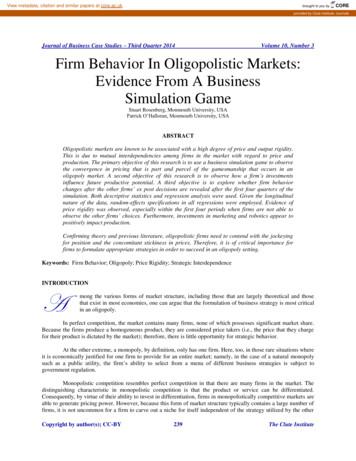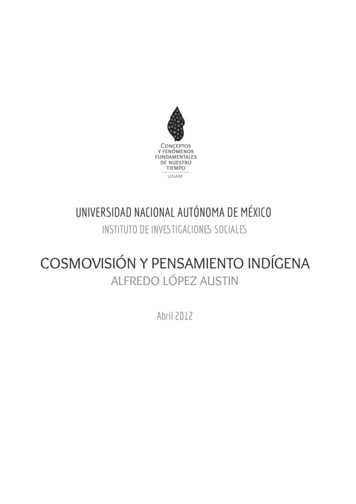Characteristics Of Monopolistic Competition
Chapter 13Monopolistic Competition and Oligopoly Monopolistic competition. Definition. Output and price determination in SR and LR. Explain why advertising costs are high in a monopolisticallycompetitive industry Oligolopoly Definition. Price and output determination – game theory Cartels Anti-trust laws and regulation of marketsMonopolistic CompetitionCharacteristics of Monopolistic competition A large number of firms. limited market power (demand relatively elastic). Independent decision making Collusion impossible Each firm produces a differentiated product. compete on product quality, price, and marketing. Firms are free to enter and exit the industry. Economic profits driven to zero in long runMonopolistic CompetitionOutput and Price in MonopolisticCompetitionMarket Share in Monopolistic CompetitionRed 4 largest.Green 5-8Blue 9-20The numbers arethe HHI.The Firm’s Short-Run Output and Price DecisionHolding quality and marketing constant, profitmaximization is achieved by choosing the price/quantitywhereMR MC1
SR Output and Price in MonopolisticCompetitionWhat is profit maximizingprice? Quantity?Output and Price in MonopolisticCompetitionLong Run: Zero Economic ProfitIn the long run, economic profit induces entry.What is the level of profit?Entry causes demand curve for existing firms to shiftdownward.What is socially efficientlevel of output?Entry continues as long as firms in the industry earn aneconomic profit—as long as (P ATC).What is the deadweightloss?SR Output and Price in MonopolisticCompetitionGiven the short runequilibrium described, whydoes entry occur?As entry occurs, demandshifts leftward until profitequals zero.Output and Price in MonopolisticCompetitionDiagram at right showslong run equilibrium for amonopolisticallycompetitive firm. economic profits? price mark-up (P vsMC)? excess capacity? socially efficient output? deadweight loss?2
Output and Price in MonopolisticCompetitionOutput and Price in MonopolisticCompetitionIs Monopolistic Competition EfficientContrast to LR equilibriumfor firms in perfectcompetition:Because in monopolistic competition P MC, marginalbenefit exceeds marginal cost (“deadweight loss”). Economic profits?But the markup of price above marginal cost arises fromproduct differentiation. Excess capacity? Socially efficient? Deadweight loss?Monopolistic competition brings the profitable and possiblyefficient amount of variety to market.Government tends not to regulate monopolisticallycompetitive markets.Product Development and MarketingProduct Development and MarketingInnovation and Product DevelopmentAdvertisingFirms in monopolisticcompetition incur heavyadvertising expenditures.To keep earning an economic profit, a firm in monopolisticcompetition must be in a state of continuous productdevelopment.New product development allows a firm to gain acompetitive edge, if only temporarily, before competitorsimitate the innovation. Why? How canadvertising be “profitable”? Changes in productdemand versus changes inATC.3
Product Development and MarketingAdvertising could increaseproduct demand and alsomake it more elastic.Profits could rise or fall.If product demandbecomes more elastic, (PMC) markup could fall.What is Oligopoly?The distinguishing features of oligopoly are: Natural or legal barriers that prevent entry of new firms A small number of firms competeProduct Development and MarketingWith advertising, the firmproduces 100 units ofoutput at an average totalcost of 40.The advertisingexpenditure shifts theaverage total cost curveupward, but the firmoperates at a higher outputand lower ATC than itwould without advertising.What is Oligopoly?Barriers to EntryEither natural or legalbarriers to entry can createoligopoly.With demand as drawn,there is a naturalduopoly—a market withtwo firms.How would answer changeif demand increases?4
What is Oligopoly?What is Oligopoly?Small Number of FirmsExamples of OligopolyAn HHI that exceeds 1800is generally regarded asan oligopoly byDepartment of Justice.Because an oligopoly market has a small number of firms,the firms are interdependent and face a temptation tocooperate.Interdependence: With a small number of firms, eachfirm’s profit depends on every firm’s actions.Cartel: A cartel is an illegal group of firms acting togetherto limit output, raise price, and increase profit.Firms in oligopoly face the temptation to form a cartel, butaside from being illegal, cartels often break down.Two Traditional Oligopoly ModelsAn HHI below 1800 isgenerally regarded asmonopolistic competition.Recall earlier caveats onHHI (e.g. geographicboundaries, entry barriers)Oligopoly GamesThe Kinked Demand Curve Model. SKIP IT.Game theoryDominant Firm Oligopoly SKIP IT. a tool for studying strategic behavior, which is behaviorthat takes into account the expected behavior of othersand the mutual recognition of interdependence.What Is a Game?All games share four features: Rules Strategies Payoffs Outcome.5
Oligopoly GamesOligopoly GamesThe Prisoners’ DilemmaNash equilibrium—first proposed by John Nash -- if aplayer makes a rational choice in pursuit of his own bestinterest, he chooses the action that is best for him, given anyaction taken by the other player.Each prisoner is told that both are suspected of committing amore serious crime.If one of them confesses, he will get a 1-year sentence forcooperating while his accomplice get a 10-year sentence forboth crimes.If both confess to the more serious crime, each receives 3years in jail for both crimes.If neither confesses, each receives a 2-year sentence for theminor crime only.Oligopoly GamesAn Oligopoly Price-Fixing Game: Cartels.What’s the NashEquilibrium?What’s 21DMR400 500600pounds per year800810121000s of pounds per year6
Oligopoly Games Based on above diagram: What is competitive price, firm output, industry output, profit? What is cartel (“collusive agreement”) price, output, profit? What is deadweight loss? Effect on consumer? Effect on producers? What is “incentive to cheat”? How is this like “prisoner’s dilemma”?Oligopoly GamesSuppose that the two firms enter into a collusiveagreement.A collusive agreement (or cartel agreement) is anagreement between two (or more) firms to restrict output,raise price, and increase profits.Such agreements are illegal in the United States and areundertaken in secret. How do each of following affect ability to enforce cartel? Entry restrictions. Ability to monitor each other.Oligopoly GamesOther Oligopoly GamesAdvertising and R & D games are also prisoners’dilemmas.Oligopoly GamesHere is the payoff matrix for the Pampers Versus Huggiesgame.An R & D GameProcter & Gamble and Kimberley Clark play an R & Dgame in the market for disposable diapers.What’s theNashEquilibrium?What’s thecollusive(cooperative)equilibrium?7
Anti-trust policyAnti-trust policy.Measuring concentration.A.DOJ formed merger guidelines in early 1980s.Likelihood of collusion and DOJ anti-trust policy. if post-merger HHI 1000 industry competitive. if 1000 HHI 1800 merger scrutinized (gray area). if HHI 1800 merger likely to be challenged (red zone).B.Difficulties in using concentration measures asindicators of competition for mergers.When HHI is in a questionable area, other factors areconsidered. Barriers to entry Ability to monitor each other’s behavior. Is the game “repeated”? geographical scope of market product boundaries firms produce multiple products.Anti-trust policyTheories of regulation. Public interest theory–politicial process generates regulations designed to achieve“socially efficient” outcome. Capture theory–regulations are designed to satisfy the demand ofproducers to maximize producer surplus.– benefit producers (concentrated group) at expense ofconsumers (disperse group).Anti-trust policyEvidence on Deregulation of 1980s.AIRLINES prices fell and volume increased. consumer surplus increased 11.8 billion producer surplus increased 4.9 billion. rapid change in structure of airline industry (hubs, excesscapacity reduced, pricing changes, etc.)TRUCKING consumer surplus increased 15.4 billion producer surplus decreased 4.8 billion. truck driver’s wages fell.8
Anti-trust policyOTHER INDUSTRIES THAT HAVE BEENDEREGULATED. natural gas long distance telephone cableDERGULATION IN PROCESS electric local telephoneAnti-trust policy1890: Sherman Act passed partly in response to the monopolizationof the oil industry. Law prohibited “combination, trust, orconspiracy to restrict interstate or internationaltrade”. Sherman Act used in 1911 to break up StandardOil (created Exxon, Sohio, Chevron, etc.)Anti-trust policyAnti-trust policy.The Standard Oil Story: John D. Rockefeller owned standard oil. Able to extract discounts from the railroads for shipping During the 1870s, Standard Oil increased its capacityfrom 10 to 90 percent of the U.S. total. In 1882, the independent members of standard oilcontributed shares to a central trust Allowed a central body to manage all firms. The central body shut down some refineries, restrictedproduction, and drove up oil prices.Anti-trust policy 1914: Clayton Act. prohibited interlocking directorates & tyingcontracts 1914: Federal Trade Commission Act created FTC to prosecute “unfair competition” outlawed misleading advertising.9
Anti-trust policy 1936: Robinson-Patman Act (Chain store law) made “quantity discounts” illegal prevented stores from selling to public at “unreasonablylow” prices. 1937: Miller-Tydings Act allowed Resale Price Maintenace if state approved. arguments against RPM (cartel enforcement) argument for RPM (high quality service) McTravel Apple computer10
Monopolistic Competition Characteristics of Monopolistic competition A large number of firms. limited market power (demand relatively elastic). Independent decision making Collusion impossible Each firm produces a differentiated product. compete on product quality, price, and
Monopolistic competition: Critical evaluation the theory of monopolistic competition with specific reference to the seminal 1977 paper by Dixit and Stiglitz Abstract This paper revisits the D-S (Dixit-Stiglitz) model. It's a simple general monopolistic model with n monopolistic goods, and a numeraire good Labour ( ); aggregation for all goods
Competition and Oligopoly Acknowledgement: BYU-Idaho Economics Department Faculty (Principal authors: Rick Hirschi, Ryan Johnson, Allan Walburger and David Barrus) Section 1 - Characteristics of Monopolistic Competition Characteristics We now turn our attention to one of the industry structures that fall between pure competition and monopolies. In
Spring 2015 Second Hour Exam . Monopoly, monopolistic competition, perfect competition. e. Monopolistic competition, perfect competition, monopoly. Use the following information for questions 27-29. Two trucking firms exist to move goods between El Paso and Midland. The fo
Monopolistic Competition Seventh Edition CHAPTER 16 Wojciech Gerson (1831-1901) Modified by Joseph Tao-yiWang In this chapter, look for the answers to these questions What market structures lie between perfect competition and monopoly, and what are their characteristics? How do monopolistically competitive firms choose price and quantity?
Monopolistic competition resembles perfect competition in that there are many firms in the market. The distinguishing characteristic in monopolistic competition is that the product or service can be differentiated. Consequently, by virtue of their ability to invest in differentiation, firms in monopolistically competitive markets are
Each can either advertise or not advertise. attracts many of its rival's customers. If neither advertises, they each capture 50 percent of the market and each earns 10 million. 2016/12/15 Imperfect Competition(s) Joseph Tao-yiWang Bonus Question1 (ALL 14-6) If they both advertise, they again split the market evenly, but each spends 2 million
The Romer Model with Monopolistic Competition and General Technology Federico Etro Working Paper N. 08/2019 DISEI, Universit a degli Studi di Firenze Via delle Pandette 9, 50127 Firenze (Italia) www.disei.uni .it The ndings, interpretations, and conclusions expressed in the working paper series are those of the authors alone.
Por Alfredo López Austin * I. Necesidad conceptual Soy historiador; mi objeto de estudio es el pensamiento de las sociedades de tradición mesoamericana, con énfasis en las antiguas, anteriores al dominio colonial europeo. Como historiador no encuentro que mi trabajo se diferencie del propio del antropólogo; más bien, ignoro si existe alguna conveniencia en establecer un límite entre .























